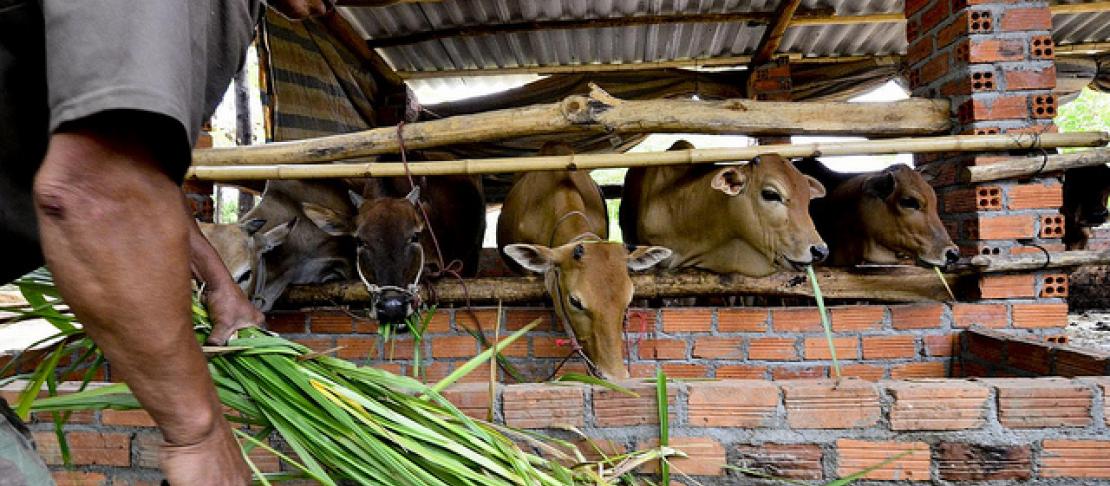Supporting low emissions development in the Latin American cattle sector (LivestockPlus)

Project description
The LivestockPlus project enabled the development and implementation of Nationally Appropriate Mitigation Actions (NAMAs) for the cattle sector in Costa Rica and Colombia. It provided technical support and generated critical information and guidelines necessary for identifying options; it also supported planning and policies for scaling up of NAMAs. Costa Rica and Colombia are respectively at the intermediate and beginning stages of NAMA development for the cattle sector. This initiative helped determine technical options for low emissions pasture development in Latin America, and how these can be scaled up using NAMAs and other policies.
Research activities and results from LivestockPlus are informing the "Agricultural innovation for the development of low-emissions cattle value chains in Latin America" project beginning in 2019.
The LivestockPlus project supported the transition towards low emission development in Costa Rica and Colombia by:
- Fostering partnerships;
- Identifying and evaluating best-fit mitigation options, and
- Evaluating measurement reporting and verification (MRV) systems for the cattle sector in the target countries.
The initiative was informed by the needs and goals of policy makers, private sector actors and cattle producers, as well as scientific evidence on the mitigation potential of different management practices. The project facilitated synergies that enable overcoming barriers to the adoption of improved management practices and, consequently, the achievement of low emission development.
Through strong engagement with key stakeholders, information generated through the project was included in the livestock NAMA concepts in Colombia and Costa Rica and is also now also influencing NAMAs in other regional countries (i.e., Peru). As of the end of 2018, we expect the implementation of these NAMAs to accelerate the adoption of improved forages, alternative feeds, etc. on over 1,000,000 ha. Research conducted through the project, which made detailed evaluations of best-bet options, will form the basis for discussions and messaging during up-scaling efforts.
Outputs
Research activities and results from this project are informing the "Agricultural innovation for the development of low-emissions cattle value chains in Latin America" project beginning in 2019.
In 2016 and 2017, LivestockPlus research informed mitigation actions for emission reductions in Latin America and globally. Studies conducted through the project were used to inform IPCC emission factors for nitrous oxide emissions from urine and dung patches. The emission factors will inform GHG inventory reports to the UNFCCC and progress towards achieving national emission reduction targets for Costa Rica and Colombia and other tropical countries.
The RUMINANT model has been validated for use in Colombia to estimate enteric methane emissions to be reported in the next GHG inventory report. A training workshop served to inform national partners. National GHG inventory compilers in Colombia have adopted the RUMINANT model and will use it for the next national communication to the UNFCCC. This model could also be used by other nations.
LivestockPlus identified best-fit mitigation options by quantifying changes in GHG fluxes, soil carbon stocks, and the productivity of cattle-based systems. Further, the project identified and implemented low-cost methods for quantifying methane and nitrous oxide emissions.
Collected data were used to inform the NAMA Information Note (NINO) development in Colombia, which included improved pastures as an option for reducing GHG emissions from the livestock sector, and the Livestock NAMA in Costa Rica. The collected data also inform decisions made at livestock roundtables in the two countries.
Project publications are available in the right column of this page.
Outputs expected over the duration of the project include:
- Data on cattle production systems (type, state, management and distribution): baselines
- Data on greenhouse gas (GHG) balances and soil carbon stocks in conventional and improved cattle production systems in the two target countries
- Policy brief on differences between GHG balance among improved low emissions pasture production systems
- Peer reviewed publication on mitigation options for cattle systems in target countries
- Methods for pasture NAMA documented and extended guidelines for SAMPLES for cattle production systems
- Review of opportunities and challenges in use of MRV systems for GHG on cattle production
- Concise report describing results of scoping meetings to set the research agenda and outlining project engagement/training strategy co-written with partners
- LivestockPlus engagement platforms for cattle production systems in Costa Rica and Colombia
- Policy brief outlining challenges and opportunities for developing livestock based NAMAs in the selected countries co-written with partners
- Training program materials/curriculum to strengthen regional capacities in GHG research for NAMA development
- Paper on lessons learned on developing NAMAs from a policy perspective
- NAMA proposal on cattle production submitted from Colombia to NAMA facility or UNFCCC
- Data on socioeconomic and biophysical components of cattle systems including gender-disaggregated data
Partners
The project team consisted of the International Center for Tropical Agriculture (CIAT), and the World Agroforestry Centre (ICRAF). Local and regional partners include Centro Agrónomico Tropical de Investigación y Enseñanza (CATIE), national ministries of agriculture, environment, forestry, risk, development and planning, and relevant universities in all project countries, like Universidad Nacional de Colombia.
Gender
Detailed gender-disaggregated data collection facilitated a better understanding of women’s roles in production and processing activities on selected farms and were used to support Livestock NAMA that ensure that the cattle sector helps to contribute to equality across gender and social groups. This includes data on the roles of women and youth in the cattle production and processing, and indicators of women's empowerment.
Further information
For further information, please contact Project Leader, Jacobo Arango (CIAT) at j.arango@cgiar.org.